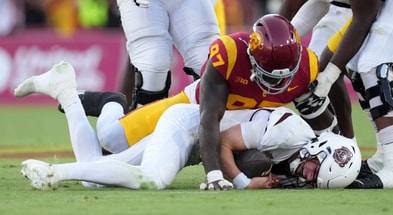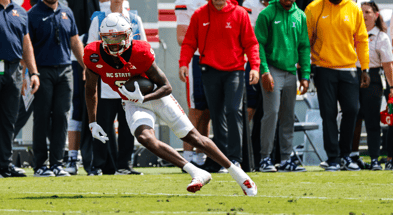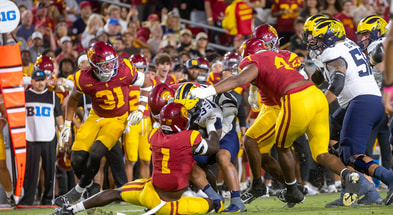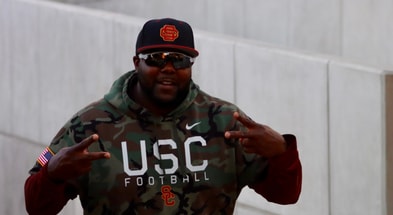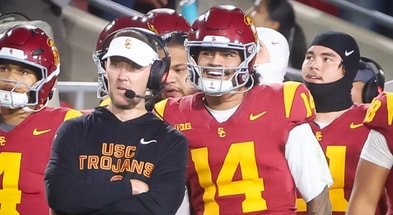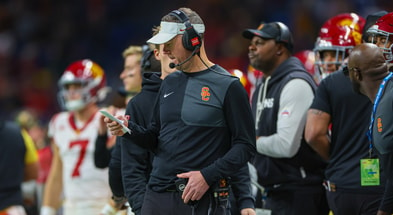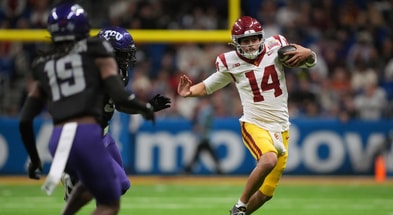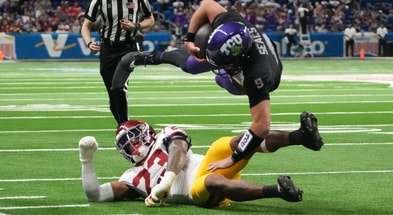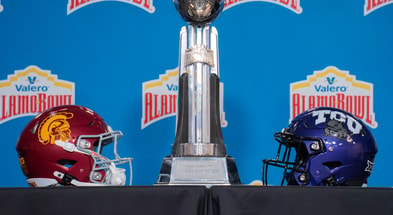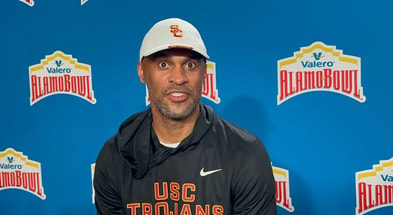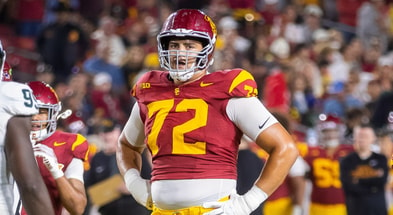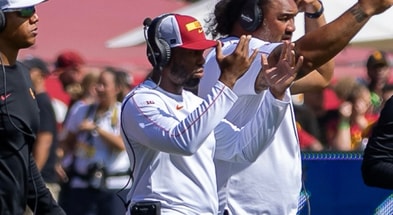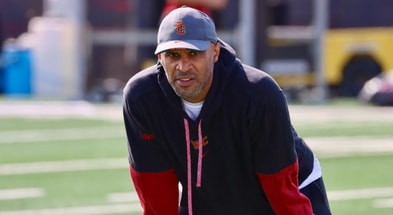Musings from Arledge: The Pac-12's demise and what's next for college football
Many of the analyses of the Pac-12’s demise are missing the primary point. Its collapse was inevitable, and the seismic changes in college football are not over. Other collapses are on the way.
John Canzano is one of the best Pac-12 writers around, with deep connections throughout the conference. His recent piece on the downfall of the conference is interesting, complete with behind-the-scenes details about the last days.
But his very interesting article focuses primarily on the last days and the personalities who oversaw the Pac-12’s death. I’m not sure that’s where the action is. The article points its finger at George Kliavkoff—“the person in the eye of the storm”—who, it seems clear, didn’t really understand what leverage the Pac-12 conference had (or didn’t have) with media entities and who strung the conference leaders along with vague reassurances that a great deal was coming. It wasn’t.
Canzano quotes Wazzu AD Pat Chun as blaming a lack of leadership for the conference’s downfall: “When there’s a void of leadership these are the outcomes you have to deal with.”
Chun is right … to a point. But the lack of leadership went higher than Kliavkoff or even Larry Scott. Point a finger at the Pac-12 chief executives. Look at their directive to Kliavkoff after the conference had received an ESPN offer of $30-million-per-team in the fall of 2022: go back with a counteroffer of $50 million. $50 million in the fall of 2022!? After USC and UCLA had already left the conference!? That’s not just bad bargaining strategy; it’s delusional. They might as well have asked for one hundred billion dollars, complete with a Dr. Evil accent and a pinky finger on the corner of their mouths. Why not tell ESPN that you want to be as profitable as Amazon and if they won’t cooperate you’ll steal a nuke and blow up New York City? That would constitute only a slightly more elevated level of crazy.
Canzano quotes a conference insider asking, “How can so many smart people make such stupid decisions?”
I have a theory. These “smart people” were academics with PhD’s in various fields, none of which provided even a shred of insight into the topic at hand, which was the value of the football product they were trying to sell. A Pac-12 conference without the LA schools isn’t a $50 million-a-year product for any media entity. It isn’t close. For them not to understand that just reminds all of us—yet again—that expertise in one field doesn’t always translate into another.
Maybe the conference executives were little different than Pac-12 fans, vastly overestimating their own program’s worth and belittling the significance of USC, which had wallowed for years in mediocrity, in part because of the NCAA sanctions, but mostly because USC was just fine with underperforming and was eager to select and retain foolish and unfit leaders like Pat Haden, Lynn Swann, Steve Sarkisian, and Clay Helton.
But USC football was still the key to the conference.
Canzano and an unnamed conference insider wonder whether Larry Scott would have lost USC and UCLA to the Big 10. “Scott had the unhappiness of the LA schools on his radar in 2009. He knew USC was a flight risk. Scott’s successor was blindsided by it.”
There is so much to unpack. Larry Scott knew in 2009 that USC was unhappy and a flight risk? Well, he certainly should have. USC was providing massive subsidies to the rest of the conference—its departure cost the remaining members $100,000,000 per year in media value according to the University of California’s analysis. $100,000,000 per year is a whole hell of a lot of charity to give away. And what, exactly, did USC get in exchange for its largesse? The conference wouldn’t even raise of word of protest when a corrupt NCAA infractions committee—as keen on due process as a Stalin-era KGB agent—arrested USC on trumped-up charges, convicted them in a fake trial, and took them down to the basement for a bullet. USC’s conference colleagues seemed thrilled; now maybe they could compete. And on top of that, USC consistently received nonsensical schedules, was frequently the victim of the world’s worst officiating, and sat and watched as the other major football powers got richer and richer.
I don’t know if it’s true that Kliavkoff didn’t realize USC was a flight risk; if so, he truly is an idiot. But it doesn’t surprise me that Larry Scott immediately realized this fact. It must have been obvious that if a conference refuses to do anything to keep its flagship program happy, it’s going to wonder about a future somewhere else. USC isn’t Oregon State; it had options. If a guy keeps his wife chained to the kitchen as he spends all of his nights dating various mistresses, she might just think about escaping as soon as she finds a key.
That Scott recognized the situation and did nothing to alleviate it is an indictment of Scott, who was a terrible conference commissioner: he lined his pockets as his pet scheme (the Pac-12 Network) was a disastrous failure year after year. But it’s also an indictment of the rest of the conference. How could they not see the absurdity of the situation and the risk it posed to them if USC should ever decide it was done with them?
Granted, they might have been lulled into complacency by Pat Haden, who seemed more interested in being admired personally than in using USC’s clout to benefit USC’s athletic department, and who gave every indication that USC was content to be a simp for the rest of the conference instead of exerting itself and, you know, winning—instead of “winning the right way,” which was code for not doing what it takes to win.
But how foolish for the rest of the conference to think that attitude would persist forever in Heritage Hall.
We can give Larry Scott credit for one thing: he at least attempted a major coup that would have put the Pac-12 in a very strong position when he tried to lure Texas and Oklahoma to the conference. There was an insight there that I’ll come to in a minute, one that was apparently lacking in the presidential suites of most of the conference, whose executives were not willing to give Texas a special deal to land two powerhouse programs that would have made the Pac-12 conference a true peer of the Big-10 and the SEC in the media-rights world. (And I suspect Scott wasn’t willing to make the deal at that price either, since it would threaten his Pac-12 Network dream.)
And this gets us to the heart of the issue. It’s the reason why conference realignment was inevitable and why it will continue. Understand, we’re not at the end of conference realignment. The tectonic plates have only begun to shift. And it’s because college football’s history was formed in a world very different from its future, and its current structure no longer makes even a bit of sense.
Here’s the first reality: money matters in college football. So much of the analysis is silly hand-wringing about greed. Oh, it’s terrible that these schools are just chasing money. Yes, they’re chasing money. And you know why? For the same reason that businesses chase money and politicians chase more tax revenue; you need money to do things. Money means better facilities, a better recruiting budget, and a better, deeper pool of people. Money is necessary if you want to compete at the highest level.
One day the rest of college football looked up and noticed Nick Saban had an army of former NFL and major-college head coaches working as analysts for his program. He had developed a college football think tank. How in the world is USC supposed to compete with that when its staff is Clay Helton, Tee Martin, and some graduate assistants?
And that’s just the tip of the iceberg. When one major power has $60 million more than another, the richer program is going to use that money to do things to strengthen its program. They’re not sitting around burning the extra cash in a fire pit. They’re using it. And the smart coaches are using it effectively. You can’t compete if you’re getting killed in the revenues department. You can’t compete with American Airlines if you can only afford a 40-year-old prop plan with duct tape keeping the wings attached.
Top 10
- 1New
Kewan Lacy
Rebels RB decides on future
- 2Hot
Nebraska QB dominoes
Huskers line up multiple visits
- 3
Kenny Minchey
Flips transfer commitment
- 4Trending
Portal Predictions
Predicting transfer commitments
- 5
Bryce Underwood
Decides on Michigan future
Get the Daily On3 Newsletter in your inbox every morning
By clicking "Subscribe to Newsletter", I agree to On3's Privacy Notice, Terms, and use of my personal information described therein.
When commentators and those who run the lesser Pac-12 programs shed tears over USC (and Oregon, Washington, Texas, Oklahoma…) chasing money, what they really mean is that USC put its desire to win over other programs’ desire to continue receiving giant subsidies. USC was apparently supposed to let Alabama and Ohio State run away with college football because programs that nobody but a small group of alums and locals care about wanted $10 million a year in charity forever.
And here’s the second reality: college football has very few producer programs. It’s not just Wazzu and Oregon State. Most teams are charity cases. The conferences were formed over many years in a time when college football was a very different beast, when sports generated far less revenue, and when travel was far more difficult, expensive, and uncommon. In those days, a conference that combined USC and Oregon State made sense.
It makes no sense now. College football is arguably the second-most-popular professional sport in America. It generates billions of dollars. And most of those revenues—particularly the critical media-rights revenues—are generated by a few programs. The University of California’s analysis that USC was worth $100,000,000 per year in media-rights value to the other teams in the conference is an obvious example. But every conference has the same dynamic. Florida State is furious that it’s stuck with a terrible media deal that is smaller than the other major conferences and is not an accurate reflection of what the Seminoles bring to the ACC’s table. Schools like Ohio State and Michigan produce far more than they get. So does Texas. So does Alabama.
With money booming, with money being a critical factor in who has an edge on Saturday evenings, with the major powers getting far less than they actually generate, and with travel being easier, cheaper, and more commonplace than it was when these conferences were formed, of course the major programs started to look at college football’s structure and wonder whether there might be a better way.
The first step in the changing world has already started. The major programs realized that collecting the top programs together would dramatically increase revenues. Oklahoma and Texas thought of jumping to the Pac-12 and eventually did jump to the SEC. USC and UCLA left, followed by Washington and Oregon. (As much as I loathe Oregon, that’s a program that does have some media juice. Not like USC or Ohio State, but far above average.) Florida State, Miami, Clemson and others will follow suit as soon as they are able. The major powers are consolidating. That’s the first step, and an obvious one.
The second step has not started, but it will, and it’s equally obvious. Because while the major programs are consolidating and reaping revenue increases, they are still subsidizing a bunch of other programs; they are still not bringing in even close to what they generate.
So the second step will be for the major powers to jettison the minor programs that take tens of millions of dollars per year in revenue but generate very little. It doesn’t take Sherlock Holmes to deduce that if you want to maximize revenue, you shed the charity cases. That hasn’t really happened yet. True, the smaller players sometimes get left behind when conferences implode. Rice and SMU were left without a good home when the Southwest Conference imploded. Wazzu and Oregon State will be stuck in purgatory with the Pac-12’s death.
But so far the major powers in the conferences have not thrown the little guys in their conferences overboard. Ohio State and Michigan are still sharing revenues with Northwestern and Purdue. Alabama still subsidizes Vanderbilt.
That is why the next move is so obvious. The current conferences will, at some point, die off. The major powers—thirty, forty?—will form a new structure outside of the current conferences and outside of the NCAA. It will be far more profitable. It will have more parity. It will be an increase in the overall level of play. It will be the death of tradition, a death that has been ongoing for many years now.
For better of worse, it will look a whole lot more like the NFL.
There’s a lot of bad there. It will also be devastating to fans of lesser programs. Those programs can continue to play football, but it won’t be at the highest level. But it’s fair to ask whether they play at the highest level now. Does Wazzu play at the highest level? It sometimes has teams that compete. But it can’t really compete with the major powers, not over the long term. It never will.
And while I understand the concern about college football’s drift towards a new, giant super conference, it’s not all bad. Is it a disaster that most professional sports leagues try to limit membership to teams that have a chance to compete? Those of you who like the NFL or the NBA: would you be in favor of expanding those leagues so they are three times as large as they currently are, when you know the expansion programs will be in small towns that because of basic structural deficiencies (fewer fans, fewer resources) cannot possibly compete with Dallas and New England? Do you need to see eight games a year where the Bears stomp hapless Dayton and Modesto? Would that make those leagues better? I don’t think so.
And if you don’t want that for the NFL, why are we so upset that Rice, Vanderbilt, Northwestern or Oregon State won’t be competing in the coming super league? It’s not clear that college football is better when teams like Georgia play only one or two games against teams that can come close to competing with them. (Seriously, I say it again: go look at their schedule. I don’t know how they can walk around with that schedule and not feel overwhelming shame.)
The changes I discuss are inevitable. And they’re not Larry Scott’s fault. They’re not George Kliavkoff’s. They’re not even the fault of the nearsighted, delusional Pac-12 executives. They were inevitable in light of how much money college football generates, and how it’s generated primarily by a small group, and how important it is that the major programs not fall behind the other major programs in revenues if they want to compete on the field.
MusingsfromArledge.substack.com. Go subscribe. It’s free.
